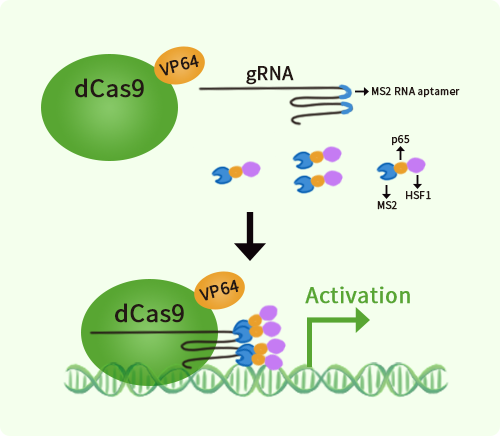Human PPM1D activation kit by CRISPRa
CAT#: GA105612
PPM1D CRISPRa kit - CRISPR gene activation of human protein phosphatase, Mg2+/Mn2+ dependent 1D
Find the corresponding CRISPRi Inhibitor Kit
USD 1,657.00
2 Weeks*
Specifications
| Product Data | |
| Format | 3 gRNAs (5ug each), 1 scramble ctrl (10ug) and 1 enhancer vector (10ug) |
| Symbol | PPM1D |
| Locus ID | 8493 |
| Kit Components | GA105612G1, PPM1D gRNA vector 1 in pCas-Guide-GFP-CRISPRa GA105612G2, PPM1D gRNA vector 2 in pCas-Guide-GFP-CRISPRa GA105612G3, PPM1D gRNA vector 3 in pCas-Guide-GFP-CRISPRa 1 CRISPRa-Enhancer vector, SKU GE100056 1 CRISPRa scramble vector, SKU GE100077 |
| Disclaimer | These products are manufactured and supplied by OriGene under license from ERS. The kit is designed based on the best knowledge of CRISPRa SAM technology. The efficiency of the activation can be affected by many factors, including nucleosome occupancy status, chromatin structure and the gene expression level of the target, etc. |
| Reference Data | |
| RefSeq | NM_003620 |
| UniProt ID | O15297 |
| Synonyms | PP2C-DELTA; WIP1 |
| Summary | The protein encoded by this gene is a member of the PP2C family of Ser/Thr protein phosphatases. PP2C family members are known to be negative regulators of cell stress response pathways. The expression of this gene is induced in a p53-dependent manner in response to various environmental stresses. While being induced by tumor suppressor protein TP53/p53, this phosphatase negatively regulates the activity of p38 MAP kinase, MAPK/p38, through which it reduces the phosphorylation of p53, and in turn suppresses p53-mediated transcription and apoptosis. This phosphatase thus mediates a feedback regulation of p38-p53 signaling that contributes to growth inhibition and the suppression of stress induced apoptosis. This gene is located in a chromosomal region known to be amplified in breast cancer. The amplification of this gene has been detected in both breast cancer cell line and primary breast tumors, which suggests a role of this gene in cancer development. [provided by RefSeq, Jul 2008] |
Documents
| Product Manuals |
| FAQs |
| SDS |
Resources
Other Versions
| SKU | Description | Size | Price |
|---|---|---|---|
| KN209328 | PPM1D - human gene knockout kit via CRISPR, HDR mediated |
USD 1,657.00 |
|
| KN209328BN | PPM1D - human gene knockout kit via CRISPR, HDR mediated |
USD 1,657.00 |
|
| KN209328LP | PPM1D - human gene knockout kit via CRISPR, HDR mediated |
USD 1,657.00 |
|
| KN209328RB | PPM1D - human gene knockout kit via CRISPR, HDR mediated |
USD 1,657.00 |
|
| KN409328 | PPM1D - KN2.0, Human gene knockout kit via CRISPR, non-homology mediated. |
USD 1,657.00 |
{0} Product Review(s)
Be the first one to submit a review






























































































































































































































































 Germany
Germany
 Japan
Japan
 United Kingdom
United Kingdom
 China
China
